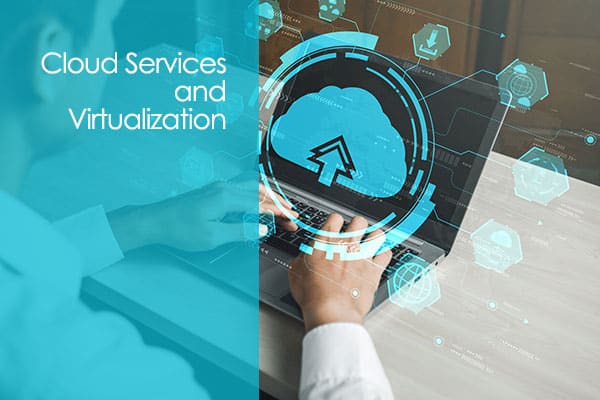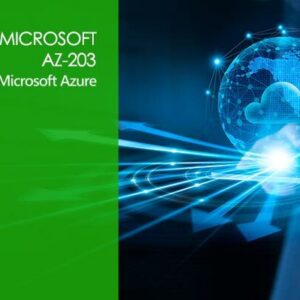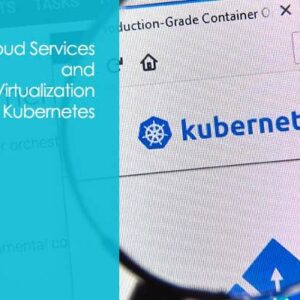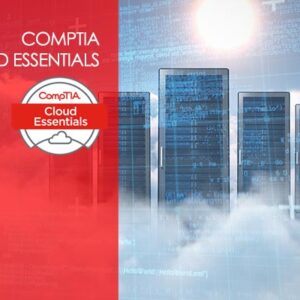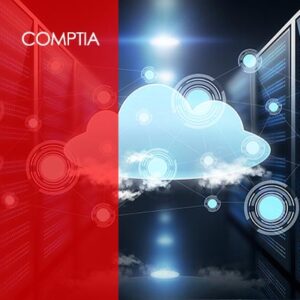Unlock the limitless potential of the cloud computing industry and embark on an exciting journey of knowledge with our exhilarating 10-course bundle! Designed to empower both IT and non-IT professionals, this transformative training experience spans over 130 hours, unraveling the concepts, purpose, and extensive use cases of cloud services and virtualization.
Imagine having the skills to effortlessly migrate your infrastructure to industry-leading platforms like Amazon Web Services (AWS) or Microsoft Azure, or even expanding your horizons by creating your own virtualized ecosystem within your organization. With this awe-inspiring bundle, you’ll gain the expertise needed to navigate the cloud computing landscape with confidence and seize the countless opportunities it presents.
Prepare to be immersed in a dynamic learning adventure that combines theoretical knowledge with practical hands-on exercises. Each course has been carefully crafted by industry experts who have distilled their wisdom into digestible modules, ensuring a seamless learning experience. From cloud architecture to data management, security to automation, and scalability to cost optimization, this bundle covers it all.
But that’s not all! We understand the importance of recognition and validation for your newly acquired skills. That’s why we have included a bonus feature: exam preparation materials! Get ready to showcase your expertise with confidence as you prepare for industry-recognized certification exams. These exams are your golden ticket to opening doors to exciting career opportunities and elevating your professional profile to new heights.
Embrace the future of technology and join the cloud computing revolution. With our comprehensive bundle, you’ll be armed with the knowledge and tools to drive innovation, enhance efficiency, and deliver exceptional results in the digital era. Don’t miss this incredible opportunity to level up your skills and become a sought-after cloud computing professional.
Enroll now and soar above the clouds! Your success in the world of cloud computing awaits.
This bundle includes the following courses:
- AWS – Introduction and Deep Dive
- AWS Certified Cloud Practitioner
- Certified Cloud Security Professional – CCSP
- Cloud Computing Security Knowledge (CCSK)
- CompTIA Cloud Essentials+ (CLO-002)
- CompTIA Cloud+ (CVO-002)
- Google Cloud Platform (GCP) Certification Training
- Microsoft AZ-203: Developing Solutions for Microsoft Azure
- Microsoft AZ-900 Microsoft Azure Fundamentals
- VMWare vSphere 6.7 Fundamentals
What do cloud computing and virtualization mean?
You will learn about cloud services and infrastructure in this training course series on cloud computing from subject-matter experts. The hardware and software resources utilized to support the delivery of cloud services are referred to as cloud computing resources. It often consists of a mix of data centers, servers, networking tools, storage devices, and other hardware, as well as the management and coordination tools and operating systems that go along with these resources. A cloud service provider often owns and manages the infrastructure for cloud technology services, making it accessible to its clients online (e.g., Google Cloud, Azure App Services, AWS Cloud Migration). Customers can then access a variety of different cloud computing resources and services using this infrastructure to host their apps, store, process, and save data.
The infrastructure for cloud services is often owned and controlled by a cloud service provider, which makes it accessible to its clients online. Customers can then access a variety of different cloud computing resources and services using this infrastructure to host their apps, store, process, and save data.
There are several different types of cloud infrastructure, including:
- The general public can access this kind of cloud infrastructure over the Internet, and it is owned and controlled by a third-party operator.
- Private cloud infrastructure is owned and managed by a single company and is not accessible to the general public.
- A business can employ a combination of on-premises and off-premises resources to serve its computing demands by utilizing a hybrid cloud, which combines elements of both public and private clouds.
- The scalability, flexibility, and high availability of cloud infrastructure make it a desirable alternative for companies and organizations that require instant access to a variety of computer resources. It also offers a means for businesses to use a pay-as-you-go or subscription-based pricing model to lower their capital expenditures on gear and software.
With our comprehensive online cloud computing class learning bundle, you may increase your knowledge of cloud computing, cloud migration and deployment, and network architecture.
Course Outline:
Google Cloud Platform (GCP) Certification Training
Module 1: Course Overview
Course Overview
Course PreReqs
Module 2: DevOps Basics
DevOps Fundamentals
What is DevOps
What are Pipelines
Continuous Integration and Delivery
Continuous Deployment
Whiteboard Build Services
Demo – DevOps Services on GCP
Module 3: App Engine PaaS
App Engine
App Engine Basics
App Engine Demo
App Engine Security Scanner Demo
App Engine or Kubernetes Engine
Module 4: Kubernetes Engine Overview
Kubernetes Engine
Kubernetes Basics
What is Kubernetes Engine
Demo – Kubernetes Engine Clusters Demo
Kubernetes Engine Application Demo
Kubernetes Engine Whiteboard
Module 5: DevOps Developer Tools
DevOps Services & Tools
Demo – Cloud SDK
Demo – Cloud Shell
Demo – Cloud Build
Demo – Container Registry
Demo – Cloud Source Repositories
Demo – Private Catalog
Demo – Artifact Registry
Module 6: Microservices
Microservices
Demo – Cloud Watch
Cloud Functions-Cloud Run
Demo – Cloud Functions
Demo – Cloud Run
Module 7: Management of your DevOps Services
Management and Monitoring
Cloud Operations
Demo – Cloud Operations
Service Accounts
Cloud Endpoints and Apigee
Demo – Workflows and Cloud Tasks
Demo – Recommendation Engine
Infrastructure as Code (IaaC)
Deployment Manager
Demo – Deployment Manager
Demo – Cloud Marketplace
Module 8: Resources and Closeout
Resources and Closeout
Course Summary
DevOps Roles and Salary Demand
Additional Resources
Google Cloud Platform Certification
Course Closeout
AWS Certified Cloud Practitioner
Module 1: Introduction to Cloud Computing
Welcome
Why Cloud Computing
What is Cloud Computing
Cloud Computing Deployment Models
Cloud Computing Types
AWS Cloud Overview
AWS Management Console Walk-Through
AWS Shared Responsibility
Summary
Module 2: Identity and Access Management IAM
IAM Overview
IAM Users & Groups Hands-On
IAM Policies Hands-On
MFA Overview
MFA Hands-On
AWS CLI
AWS CLI Installation Hands-On
AWS CLI Hands-On
IAM Roles
IAM Roles Hands-On
IAM Security Tools
IAM Security Tools Hands-On
IAM Best Practices
Shared Responsibility Model for IAM
IAM Summary
Module 3: Elastic Cloud Computing EC2
Budget Setup
EC2 Overview
EC2 Instance Hands-On
Security Groups
Security Groups Hands-On
SSH Overview
SSH Using Putty-Windows
SSH Using CMD-Windows
EC2 Instance Connect
EC2 Instance Roles
EC2 Launch Types
Shared Responsibility Model for EC2
EC2 Summary
Module 4: EC2 Storage
Intro to EC2 Instance Storage
EBS Volume Overview
EBS Volume Hands-On
EBS Snapshots
EBS Snapshots Hands-On
AMI Overview
AMI Hands-On
EC2 Instance Store
EC2 Instance Store Hands-On
Elastic File System – EFS
Shared Responsibility Model for EC2 Storage
Section Cleanup
EC2 Instance Storage Summary
Module 5: Elastic Load Balancer and Auto Scaling Group ELB and ESG
Introduction to Scalability & High-Availability
High Availability, Scalability, and Elasticity
ELB Overview
ELB Hands-On
ASG Overview
ASG Hands-On
Section Cleanup
Summary
Module 6: Amazon S3
S3 Introduction
S3 Overview
S3 Hands-On
S3 Security
S3 Bucket Policies Hands-On
S3 Websites
S3 Website Hands-On
S3 Versioning
S3 Versioning Hands-On
S3 Access Logs
S3 Access Logs Hands-On
S3 Replication
S3 Replication Hands-On
S3 Storage Classes
Snowball, Snowball Edge, and SnowMobile
S3 Summary
Module 7: Database and Analytics
Database Introduction
RDS & Aurora Overview
RDS Database Hands-On
ElastiCache Overview
DynamoDB Overview
DynamoDB Hands-On
RedShift Overview
Amazon EMR Overview
Athena Overview
AWS Glue
DMS Overview
Database & Analytics Summary
Module 8: Other Services
Other Computer Introduction
ECS-Fargate-ECR Overview
What is Serverless
AWS Lambda
AWS Lambda Hands-On
AWS Batch
AWS LightSail
AWS LightSail Hands-On
Other Compute Summary
Module 9: Scaling Your Infrastructure
CloudFormation Overview
Cloud Formation Hands-On
Elastic Beanstalk Overview
Elastic Beanstalk Hands-On
AWS CodeDeploy
AWS SSM
AWS OpsWorks
Infrastructure at Scale Summary
Module 10: Global Applications
Why Global Application
Route 53
Route 53 Hands-On
CloudFront
CloudFront Hands-On
S3 Transfer Acceleration
AWS Global Accelerator
Global Application Summary
Module 11: Cloud Integration
Cloud Integration Introduction
SQS Service
SQS Service Hands-On
SNS Service
SNS Service Hands-On
Cloud Integration Summary
Module 12: Cloud Monitoring
CloudWatch Metrics and Alarms
CloudWatch Metrics and Alarms Hands-On
CloudWatch Logs
CloudWatch Events and EventBridge
CloudWatch Events and EventBridge Hands-On
CloudTrail
X-Ray
Service Health Dashboard
Personal Health Dashboard
Monitoring Summary
Module 13: Virtual Private Network
Settings the Expectations
VPC and subnets, Internet Gateway, and NAT Gateways
VPC and subnets, Internet Gateway and NAT Gateways-Hands-On
NACL and Security Groups
NACL and Security Groups Hands-On
VPC Flow Logs
VPC Peering
VPC Flow Logs and VPC Peering Hands-On
VPC Endpoints
VPC Endpoints Hands-On
Site-to-Site VPNs and Direct Connect
Transit Gateway
VPC Summary
Module 14: Security and Compliance
Introduction to Security and Compliance
DDoS Mitigation
Penetration Testing
KMS and CloudHSM
Secrets Manager
AWS Artifact
GuardDuty
Inspector
AWS Config
AWS Macie
Security and Compliance Summary
Module 15: Machine Learning
Amazon Rekognition
Amazon Transcribe
Amazon Polly
Amazon Translate
Amazon Lex and Connect
Amazon Comprehend
Amazon SageMaker
Machine Learning Summary
Module 16: Advanced Identity
Amazon Cognito
Directory Services
Single Sign-On (SSO)
Advanced Identity Summary
Module 17: Are You Well-Architected?
Are You Well-Architected
Operational Excellence
Security
Reliability
Performance Efficiency
Cost Optimization
Trusted Advisor
Module 18: Congratulations & Exam Preparation
Exam Tips & Congratulations
Microsoft AZ-900 Microsoft Azure Fundamentals
Module 1: Introduction
Instructor Introduction
Course Overview
Expectations
Module 2: Cloud Fundamentals
What is the Cloud
Basic Terms
Types of cloud computing
Cloud Service Models
Module 3: Azure’s Architecture
Regions and Availability
Resource Groups and Management
Azure Marketplace
Demo- Azure Console Exploration
Module 4: Compute
Virtual Machines
Containers
Demo – Containers
Functions
Demo – Functions
Windows Virtual Desktop and App Services
Module 5: Networking and CDN
Virtual Networks
Load Balancers
Gateways
Content Delivery Network
Network Security
Demo – Connecting two VMs
Module 6: Storage
Storage
Big Data and Analytics
Databases
Demo – SQL Database
Database Migration
Module 7: Azure Solutions
IoT
Demo – IoT Hub
AI
Serverless Computing
Module 8: Administration
Security
Identity and Access Management
Demo – Adding Users and Groups
Governance
Demo – Resource Locks
Privacy and Compliance
Module 9: Pricing and Service Level Agreements
Managing Costs
Demo – Pricing Calculator
Service Level Agreements and Service Lifecycles
Module 10: Exam Preparation
Exam Layout
Best Practices and Study Tips
Overview and Conclusion
Module 11: Review Questions
Module 11 pt 1
Module 11 pt 2
Module 11 pt 3
Module 11 pt 4
CompTIA Cloud Essentials+ (CLO-002)
Module 1: Understanding Cloud Computing Concepts
Course Intro
Understand Basic Cloud Concepts and Terms Pt 1
Understand Basic Cloud Concepts and Terms Pt 2
Understand Basic Cloud Concepts and Terms Activity
Identify Cloud Networks and Cloud Storage Technologies
Identify Cloud Network and Cloud Storage Technologies Activity
Recognize Cloud Design Aspects
Recognize Cloud Design Aspects Activity
Module 2: Applying Cloud Business Principles
Relate Cloud Concepts to Business Principles
Relate Cloud Concepts to Business Principles Activity
Establish Cloud Vendor Relations
Establish Cloud Vendor Relations Activity
Distinguish the Financial Aspects of Engaging a Cloud Service Provider
Distinguish the Financial Aspects of Engaging a Cloud Service Provider Activity
Report Financial Expenditures
Report Financial Expenditures Activity
Module 3: Advising a Cloud Design and Migration
Relate Cloud Concepts to Cloud Design and Migration
Relate Cloud Concepts to Cloud Design and Migration Activity
Use Cloud Assessments
Use Cloud Assessments Activity
Manage Cloud Design
Manage Cloud Design Activity
Compare Cloud Migration Approaches
Compare Cloud Migration Approaches Activity
Identity Benefits and Solutions of Cloud Services
Identity Benefits and Solutions of Cloud Services Activity
Module 4: Operating in the Cloud
Relate Cloud Concepts to Technical Operations
Relate Cloud Concepts to Technical Operations Activity
Identify the Technical Aspects of Cloud Operations
Identify the Technical Aspects of Cloud Operations Activity
Understand DevOps in the Cloud
Understand DevOps in the Cloud Activity
Explain Cloud Security Concerns, Measures, and Concepts Part 1
Explain Cloud Security Concerns, Measures, and Concepts Part 2
Explain Cloud Security Concerns, Measures, and Concepts Activity
Module 5: Managing Cloud Governance
Relate Cloud Concepts to Governance
Relate Cloud Concepts to Governance Activity
Apply Risk Management Concepts
Apply Risk Management Concepts Activity
Understand Compliance and the Cloud
Understand Compliance and the Cloud Activity
Manage Policies and Procedures for Cloud Services
Manage Policies and Procedures for Cloud Services Activity
Module 6: Exam Information, Review, and Summary
Exam Information
Exam Review Pt 1
Exam Review Pt 2
Exam Review Pt 3
Exam Review Pt 4
Module 7: Activities
Apply Risk Management Concepts Activity
Compare Cloud Migration Approaches Activity
Distinguish the Financial Aspects of Engaging a Cloud Service Provider Activity
Establish Cloud Vendor Relations Activity
Explain Cloud Security Concerns, Measures, and Concepts Activity
Identify Cloud Network and Cloud Storage Technologies Activity
Identify the Technical Aspects of Cloud Operations Activity
Identity Benefits and Solutions of Cloud Services Activity
Manage Cloud Design Activity
Manage Policies and Procedures for Cloud Services Activity
Recognize Cloud Design Aspects Activity
Relate Cloud Concepts to Business Principles Activity
Relate Cloud Concepts to Cloud Design and Migration Activity
Relate Cloud Concepts to Governance Activity
Relate Cloud Concepts to Technical Operations Activity
Report Financial Expenditures Activity
Understand Basic Cloud Concepts and Terms Activity
Understand Compliance and the Cloud Activity
Understand DevOps in the Cloud Activity
Use Cloud Assessments Activity
Module 8: Tools and Resources
AWS Tools and Resources
Azure Tools and Resources
GCP Tools and Resources
CompTIA Cloud+ (CVO-002)
Module 1: Preparing to Deploy Cloud Solutions
Course Introduction
Instructor Intro
Describe the Interaction of Cloud Components and Services
Activity Scenario Introduction
Describe the Interaction of Cloud Components and Services Activity
Describe the Interaction of Non-cloud Components and Services
Describe the Interaction of Non-cloud Components and Services Activity
Evaluate Existing Components and Services for Cloud Deployment
Evaluate Existing Components and Services for Cloud Deployment Activity
Evaluate Automation and Orchestration Options
Evaluate Automation and Orchestration Options Activity
Prepare for Cloud Deployment
Prepare for Cloud Deployment Activity
Module 2: Deploying a Pilot Project
Manage Change in a Pilot Project
Manage Change in a Pilot Project Activity
Execute Cloud Deployment Workflow
Execute Cloud Deployment Workflow Activity
Complete Post-Deployment Configuration
Complete Post-Deployment Configuration Activity
Module 3: Testing Pilot Project Deployments
Identify Cloud Service Components for Testing
Identify Cloud Service Components for Testing Activity
Test for High Availability and Accessibility
Test for High Availability and Accessibility Activity
Perform Deployment Load Testing
Perform Deployment Load Testing Activity
Analyze Test Results
Analyze Test Results Activity
Module 4: Designing a Secure and Compliant Cloud Infrastructure
Design Cloud Infrastructure for Security
Design Cloud Infrastructure for Security Activity
Determine Organizational Compliance Needs
Determine Organizational Compliance Needs Activity
Module 5: Designing and Implementing a Secure Cloud Environment
Design Virtual Network for Cloud Deployment
Design Virtual Network for Cloud Deployment Activity
Determine Network Access Requirements
Determine Network Access Requirements Activity
Secure Networks for Cloud Interaction
Secure Networks for Cloud Interaction Activity
Manage Cloud Component Security
Implement Security Technologies
Implement Security Technologies Activity
Module 6: Planning Identity and Access Management for Cloud Deployments
Determine Identity Management and Authentication Technologies
Determine Identity Management and Authentication Technologies Activity
Plan Account Management Policies for the Network and Systems
Plan Account Management Policies for the Network and Systems Activity
Control Access to Cloud Objects
Control Access to Cloud Objects Activity
Provision Accounts
Provision Accounts Activity
Module 7: Determine CPU and Memory Sizing for Cloud Deployments
Determine CPU Size for Cloud Deployment
Determine CPU Size for Cloud Deployment Activity
Determine Memory Size for Cloud Deployment
Module 8: Determining Storage Requirements for Cloud Deployments
Determine Storage Technology Requirements
Determine Storage Technology Requirements Activity
Select Storage Options for Deployment
Select Storage Options for Deployment Activity
Determine Storage Access and Provisioning Requirements
Determine Storage Access and Provisioning Requirements Activity
Determine Storage Security Options
Determine Storage Security Options Activity
Module 9: Analyzing Workload Characteristics to Ensure Successful Migration
Determine the Type of Cloud Deployment to Perform
Determine the Type of Cloud Deployment to Perform the Activity
Manage Virtual Machine and Container Migration
Manage Virtual Machine and Container Migration Activity
Manage Network, Storage, and Data Migration
Manage Network, Storage, and Data Migration Activity
Module 10: Maintaining Cloud Systems
Patch Cloud Systems
Patch Cloud Systems Activity
Design and Implement Automation and Orchestration for Maintenance
Design and Implement Automation and Orchestration for Maintenance Activity
Module 11: Implementing Backup, Restore, Disaster Recovery, and Business
Continuity Measures
Back-Up and Restore Cloud Data
Back-Up and Restore Cloud Data Activity
Implement Disaster Recovery Plans
Implement Disaster Recovery Plans Activity
Implement Business Continuity Plans
Implement Business Continuity Plans Activity
Module 12: Analyzing Cloud Systems for Performance
Monitor Cloud Systems to Measure Performance
Monitor Cloud Systems to Measure Performance Activity
Optimize Cloud Systems to Meet Performance Criteria
Optimize Cloud Systems to Meet Performance Criteria Activity
Module 13: Analyzing Cloud Systems for Anomalies and Growth Forecasting
Monitor for Anomalies and Resource Needs
Monitor for Anomalies and Resource Needs Activity
Plan for Capacity
Plan for Capacity Activity
Create Reports on Cloud System Metrics
Create Reports on Cloud System Metrics Activity
Module 14: Troubleshooting Deployment, Capacity, Automation, and Orchestration
Issues
Troubleshoot Deployment Issues
Troubleshoot Deployment Issues Activity
Troubleshoot Capacity Issues
Troubleshoot Capacity Issues Activity
Troubleshoot Automation and Orchestration Issues
Troubleshoot Automation and Orchestration Issues Activity
Module 15: Troubleshooting Connectivity Issues
Identify Connectivity Issues
Identify Connectivity Issues Activity
Troubleshoot Connectivity Issues
Troubleshoot Connectivity Issues Activity
Module 16: Troubleshooting Security Issues
Troubleshoot Identity and Access Issues
Troubleshoot Identity and Access Issues Activity
Troubleshoot Attacks
Troubleshoot Attacks Activity
Troubleshoot Other Security Issues
Troubleshoot Other Security Issues Activity
Module 17: Exam Information, Review, and Summary
Exam Information
Course Review
Module 18: Activities
Activity Scenario Introduction
Describe the Interaction of Cloud Components and Services Activity
Describe the Interaction of Non-cloud Components and Services Activity
Evaluate Existing Components and Services for Cloud Deployment Activity
Evaluate Automation and Orchestration Options Activity
Prepare for Cloud Deployment Activity
Manage Change in a Pilot Project Activity
Execute Cloud Deployment Workflow Activity
Complete Post-Deployment Configuration Activity
Identify Cloud Service Components for Testing Activity
Test for High Availability and Accessibility Activity
Perform Deployment Load Testing Activity
Analyze Test Results Activity
Design Cloud Infrastructure for Security Activity
Determine Organizational Compliance Needs Activity
Design Virtual Network for Cloud Deployment Activity
Determine Network Access Requirements Activity
Secure Networks for Cloud Interaction Activity
Implement Security Technologies Activity
Determine Identity Management and Authentication Technologies Activity
Plan Account Management Policies for the Network and Systems Activity
Control Access to Cloud Objects Activity
Provision Accounts Activity
Determine CPU Size for Cloud Deployment Activity
Determine Storage Technology Requirements Activity
Select Storage Options for Deployment Activity
Determine Storage Access and Provisioning Requirements Activity
Determine Storage Security Options Activity
Determine the Type of Cloud Deployment to Perform the Activity
Manage Virtual Machine and Container Migration Activity
Manage Network, Storage, and Data Migration Activity
Patch Cloud Systems Activity
Design and Implement Automation and Orchestration for Maintenance Activity
Back-Up and Restore Cloud Data Activity
Implement Disaster Recovery Plans Activity
Implement Business Continuity Plans Activity
Monitor Cloud Systems to Measure Performance Activity
Optimize Cloud Systems to Meet Performance Criteria Activity
Monitor for Anomalies and Resource Needs Activity
Plan for Capacity Activity
Create Reports on Cloud System Metrics Activity
Troubleshoot Deployment Issues Activity
Troubleshoot Capacity Issues Activity
Troubleshoot Automation and Orchestration Issues Activity
Identify Connectivity Issues Activity
Troubleshoot Connectivity Issues Activity
Troubleshoot Identity and Access Issues Activity
Troubleshoot Attacks Activity
Troubleshoot Other Security Issues Activity
Certified Cloud Security Professional – CCSP
Cloud Concepts, Architecture, and Design
Course Intro
Cloud Concepts, Architecture, and Design – Part 1
Cloud Concepts, Architecture, and Design – Part 2
Cloud Concepts, Architecture, and Design – Part 3
Cloud Concepts, Architecture, and Design – Part 4
Cloud Concepts, Architecture, and Design – Part 5
Cloud Concepts, Architecture, and Design – Part 6
Cloud Concepts, Architecture, and Design – Part 7
Cloud Concepts, Architecture, and Design – Part 8
Cloud Concepts, Architecture, and Design – Part 9
Legal, Risk, and Compliance
Legal, Risk, and Compliance Part 1
Legal, Risk, and Compliance Part 2
Legal, Risk, and Compliance Part 3
Legal, Risk, and Compliance Part 4
Legal, Risk, and Compliance Part 5
Legal, Risk, and Compliance Part 6
Legal, Risk, and Compliance Part 7
Cloud Data Security
Cloud Data Security – Part 1
Cloud Data Security – Part 2
Cloud Data Security – Part 3
Cloud Data Security – Part 4
Cloud Data Security – Part 5
Cloud Data Security – Part 6
Cloud Data Security – Part 7
Cloud Platform and Infrastructure Security
Cloud Platform and Infrastructure Security – Part 1
Cloud Platform and Infrastructure Security – Part 2
Cloud Platform and Infrastructure Security – Part 3
Cloud Platform and Infrastructure Security – Part 4
Cloud Platform and Infrastructure Security – Part 5
Cloud Platform and Infrastructure Security – Part 6
Cloud Platform and Infrastructure Security – Part 7
Cloud Platform and Infrastructure Security – Part 8
Cloud Application Security
Cloud Application Security – Part 1
Cloud Application Security – Part 2
Cloud Application Security – Part 3
Cloud Application Security – Part 4
Cloud Application Security – Part 5
Cloud Application Security – Part 6
Cloud Application Security – Part 7
Cloud Application Security – Part 8
Cloud Application Security – Part 9
Cloud Security Operations
Cloud Security Operations – Part 1
Cloud Security Operations – Part 2
Cloud Security Operations – Part 3
Cloud Security Operations – Part 4
Cloud Security Operations – Part 5
Cloud Security Operations – Part 6
Cloud Security Operations – Part 7
Cloud Security Operations – Part 8
Cloud Security Operations – Part 9
Cloud Security Operations – Part 10
Cloud Security Operations – Part 11
Course Outro
AWS – Introduction and Deep Dive
Module 1: Introduction to AWS Basics
1.1 Instructor Intro
1.2 AWS Basic Intro
1.3 What Is AWS
1.4 Advantages of cloud computing
1.5 Types of cloud computing
Module 2: AWS Web Services and Cloud Platform Services
2.1 Console
2.2 CLI
2.3 Compute/EC2
2.4 Database-RDS
2.5 Networking and content delivery
2.6 Analytics
2.7 SQS-SNS
2.8 Workmail
2.9 SES
2.10 Systems manager
2.11 CloudTrail
2.12 Route53
2.13 Elastic Load Balancing (ELB)
2.14 Certificate manager
2.15 Directory service
2.16 Amazon Simple Storage Service (S3)
2.17 Identity and Access Management (IAM)
Module 3: AWS Basic Summary
3.1 AWS Basic Summary
Module 4: Introduction to AWS Deep Dive
4.1 AWS Deep Dive Intro
Module 5: AWS Management of Services and Features Deep Dive
5.1 VPC and Endpoint services pt 1
5.1 VPC and Endpoint services pt 2
5.2 DNS (Route 53)
5.3 Elastic Load Balancing (ELB) & Certificate Manager pt 1
5.3 Elastic Load Balancing (ELB) & Certificate Manager pt 2
5.4 Compute-EC2 Stand alone and SA with AR pt 1
5.4 Compute-EC2 Stand alone and SA with AR pt 2
5.5 ASG and Suspended ASG processes pt 1
5.5 ASG and Suspended ASG processes pt 2
5.6 Code deploy pt 1
5.6 Code deploy pt 2
5.7 Backups-Recovery of EC2 pt 1
5.7 Backups-Recovery of EC2 pt 2
5.7 Backups-Recovery of EC2 pt 3
5.8 RDS pt 1
5.8 RDS pt 2
5.8 RDS pt 3
5.9 Directory service
5.10 Identity and Access Management (IAM) pt 1
5.10 Identity and Access Management (IAM) pt 2
5.11 Amazon Simple Storage Service (S3)
5.12 SES
5.13 Cloudwatch
5.14 Cloudtrail
Module 6: AWS Deep Dive Summary
6.1 AWS Deep Dive Summary
Microsoft AZ-203: Developing Solutions for Microsoft Azure
Module 1: Implement VM Solutions
Intro
Implement VM Solutions Pt 1
Implement VM Solutions Pt 2
Implement VM Solutions Pt 3
Implement VM Solutions Pt 4
Implement Batch Jobs Using AZ Batch Services
Create Containerized Solutions Pt 1
Create Containerized Solutions Pt 2
Module 2: Develop Azure Platform as a Service
Develop Azure Platform as a Service (PaaS) Pt 1
Develop Azure Platform as a Service (PaaS) Pt 2
Develop Azure Platform as a Service (PaaS) Pt 3
Develop Azure Platform as a Service (PaaS) Demo Pt 1
Develop Azure Platform as a Service (PaaS) Demo Pt 2
Create Azure App Service Mobile Apps
Create Azure App Service API Apps
Implement Azure Functions Pt 1
Implement Azure Functions Pt 2
Module 3: Develop for Azure Storage
Develop for Azure Storage Pt 1
Develop for Azure Storage Pt 2
Develop for Azure Storage Pt 3
Develop Solutions that use Azure Cosmos DB Pt 1
Develop Solutions that use Azure Cosmos DB Pt 2
Develop Solutions that use Relational Database Pt 1
Develop Solutions that use Relational Database Pt 2
Develop Solutions that use Microsoft Blob Storage
Module 4: Implement Azure Security
Implement Azure Security Pt 1
Implement Azure Security Pt 2
Implement Azure Security Pt 3
Implementing Access Control Pt 1
Implementing Access Control Pt 2
Implementing Secure Data Solutions
Module 5: Monitor, Troubleshoot, and Optimize Azure Solutions
Monitor, Troubleshoot, and Optimize Azure Solutions Pt 1
Monitor, Troubleshoot, and Optimize Azure Solutions Pt 2
Develop Code Scalability
Instrument Solutions to Support Monitoring and Logging
Integrate Caching and Content Delivery Pt 1
Integrate Caching and Content Delivery Pt 2
Module 6: Connect to and Consume Azure and Third-Party Services
Connect to and Consume Azure and Third Party Services Pt 1
Connect to and Consume Azure and Third Party Services Pt 2
Working with Azure Search
Azure API Management
Develop Event-Based Solutions Pt 1
Develop Event-Based Solutions Pt 2
Develop Message-Based Solutions Pt 1
Develop Message-Based Solutions Pt 2
Outro
VMWare vSphere 6.7 Fundamentals
Chapter 1: Course Introduction and Methodology
Chapter 2: Virtualization Overview
Chapter 3: Planning and Installing ESXi
Chapter 4: Using Tools to Administer a VMware Environment
Chapter 5: vCenter and Licensing
Chapter 6: Configuring Networking
Chapter 7: Configuring Storage
Chapter 8: VM Creation, Configuration, and Snapshots
Chapter 9: Security and Permissions
Chapter 10: Host and VM Monitoring
Chapter 11: Advanced ESXi and vCenter Server Management
Chapter 12: Patching and Upgrading ESXi
Chapter 13: Disaster Recovery and Backup
Cloud Computing Security Knowledge (CCSK)
Module 1: Architecture
Cloud Security Overview-Part1
Cloud Security Overview-Part2
Cloud Diagrams
Cloud Services
Module 2: Governance and Enterprise Risk
Risk Management
Corporate Governance
Enterprise Risk Management
Risk Management Balance Process Supply Chain Security
ERM Incidents Recommendations-Part1
ERM Incidents Recommendations-Part2
ERM Incidents Recommendations-Part3
Module 3: Legal Issues- Contracts and Electronic
Cloud Legal Issues-Part1
Cloud Legal Issues-Part2
Cloud Legal Issues-Part3
Module 4: Compliance and Audit Management
Audits
Compliance And Audit
Audit Recommendations
Audit Requirements
Module 5: Information Management and Data Security
Information And Security
Storage
Information Governance Classification
Data Security
Protecting Data Moving
Client Database Encryption
PaaS Encryption
Module 6: Interoperability and Portability
Interoperability And Portability
Interoperability Recommendations
Portability Recommendations
Recommendations SAAS
Module 7: Traditional Security, Business Continuity, and Disaster Recovery
Business Continuity And Disaster Recovery
Assessing CSP Security
Equipment Maintenance
Recommendations
Module 8: Data Center Operations
Data Center Operations
Module 9: Incident Response
Incident Response
Testing
IaaS
C.E.R.- Containment, Eradication, And Recovery
Module 10: Application Security
Application Security
Security Testing
Audit Compliance
Security Assurance Recommendations
Module 11: Encryption and Key Management
Encryption And Key Management
Content-Aware Encryption
Storage Of Keys
Module 12: Identity, Entitlement, and Access Management
Building Access Control
Intro To Identity
Entitlement Process
Trust With Identity
Recommendations For Identity Management
Module 13: Virtualization
Virtualization
Hypervisor And Virtual Machine
Inter-Virtual Machine Attacks
Virtual Machine Encryption
Virtual Machine Recommendations And Requirements
Module 14: Security as a Service
Security As A Service
Security Offerings
Intrusion Detection Prevention
Business Continuity And Disaster Recovery
European CCSK
Top Security Benefits
European Legal-Based Issues
Frequently Asked Questions About Cloud Computing Courses – 10 Course Series
What does the Cloud Computing Courses bundle cover?
How is the online course content delivered?
What topics are covered in the Microsoft Azure Fundamentals – AZ900 course?
What will I learn in the Microsoft AZ-203: Developing Solutions for Microsoft Azure course?
What is the content of the Microsoft 70-487: Developing Microsoft Azure and Web Services course?
How does this training series support professional development?
Your Training Instructors

Danny Pugh
IT Instructor
Danny Pugh is a highly experienced IT professional with a comprehensive background in Cloud Engineering. He has demonstrated an impressive career trajectory, marked by a series of significant achievements and responsibilities.

Dean Bushmiller
Lead Instructor for Expanding Security
Dean has had fun for the past 20 years learning and teaching everything he can in technology and security. His consulting experience in accounting systems, inventory control, migrations, and patch management has breathed life into his 12 years in the classroom. Dean is a courseware developer who specializes in CISSP and security training. He is the lead instructor for Expanding Security and teaches online as his main job. As a non-military person, he is a proud recipient of six mission coins.

Tom Kinser
IT Instructor
Tom has years of experience building software for health insurance providers, medical providers, retail businesses, manufacturing, and both federal and state governments. His experience includes roles as a software designer, developer, and data analyst for Blue Cross Blue Shield of GA, Federated Stores (now Macy’s), Tull Metals, Hughston Orthopaedic Clinic, and Director of IT for Health Images Inc. More recently he developed cash management software for the USDA Forest Service and Bureau of Land Management.
Tom enjoys teaching. He continues to help students and fellow employees learn the latest technologies to further their careers. Tom has been a Microsoft Certified Trainer since 1996 and has instructed thousands of students worldwide. He teaches courses related to application design, coding, security, database administration, and cloud services.
